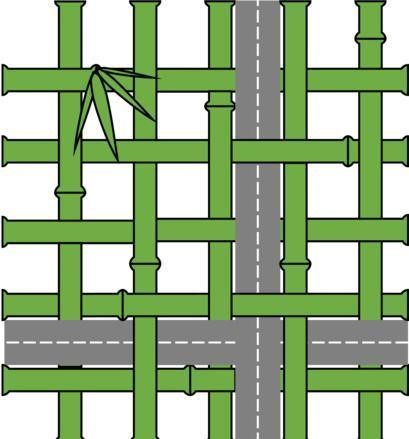SaveGREEN - Building Bridges
30-11-2020
Aiming to introduce its preliminary work on the planning of a green bridge installation in the Novohrad-Nógrád Slovak-Hungarian cross-border pilot area, SaveGREEN’s Associated Strategic Partner, the Slovak National Motorway Company, took part in the 5th session of the IUCN Infrastructure and Nature webinar series “Balancing Ecological Connectivity and Linear Infrastructure.”
Green Infrastructure from every possible angle, the IUCN Infrastructure and Nature webinar series started gathering since 1 October the leading private and public sector actors on the financing, planning, and development of sustainable infrastructure to explore the solutions for reducing risks and generating incentives for building nature into future infrastructure business models. Running until 10 December, the webinar series is setting the stage for the Infrastructure and Nature Pavilion to be convened at the 2021 IUCN World Conservation Congress.

On its second-to-last session, held on 19 November, the Slovak National Motorway Company (NDS), Associated Strategic Partner of the SaveGREEN project, presented their experience and insights on the green bridge that they built in the context of the Alpine-Carpathian Corridor (AKK) project. Representing NDS, engineers Tamara Látková and Milan Psotný, gave a walkthrough from the very initial selection of the right site for the bridge to conducting an environmental impact assessment (EIA) to ensure that the bridge was well integrated into the surrounding landscape.
The NDS representatives then proceeded to detail the monitoring activities conducted at the bridge to ensure it was effectively used. Based on this monitoring, additional mitigation measures were proposed to further encourage wildlife to use the green bridge. Látková and Psotný concluded by noting that humans have also been observed crossing the bridge, representing the second most prevalent species. Needless to say, this needs to be discouraged, as they scare away other animals and thus reduce the effectiveness of the crossing.
Within the SaveGREEN project, NDS, alongside WWF Slovakia, the State Nature Conservancy of the Slovak Republic, and SPECTRA will plan a green bridge and monitor the surrounding land for ecological corridors in the Novohrad-Nógrád Slovak-Hungarian transboundary pilot area.
Deep dive into the webinar
WWF-CEE, Lead Partner of the SaveGREEN consortium, participated as a critical actor in the organisation of the webinar series, alongside over 20 other organisations. Bringing forth the extensive know-how and experience that was collected during the DTP Interreg TRANSGREEN and ConnectGREEN projects, WWF-CEE made numerous valuable contributions to the organisation of the webinar series, while also having received many useful insights from other actors from around the world who have been working on ecological connectivity and who will further inform on the on-going activities under SaveGREEN.
During the webinar, Kate Newman, Vice President for Sustainable Infrastructure and Public Sector Initiatives with WWF US, noted that while this time is one of uncertainty and tragedy for many, it is also a time of opportunity to think about how we got here and what we can do going forward. In her words, ‘we need nature to be able to function because its resilience is our resilience.’
Rob Ament, Senior Conservationist at the Center for Large Landscape Conservation and Co-Chair of the Transport Working Group of the IUCN WCPA Connectivity Conservation Specialist Group, noted that more than 50 % of the planet is now covered by human-dominated landscapes. The Earth is currently covered by 33.5 million kilometres of paved and unpaved roads, and a further 25 million km of new road lanes are projected to be built by 2050.
 Then, both Wendy Elliot, Deputy Leader of WWF’s Wildlife Practice, and Andreas Seiler, Senior Researcher at the Swedish University of Agricultural Sciences and Chairperson of the Scientific and Expert Committee of the Infrastructure and Ecology Network Europe (IENE), noted the significant advances that have been made in research on ecological connectivity and the wealth of knowledge that exists for solutions that can be implemented. Among other resources, they cited the TRANSGREEN Wildlife and Traffic Guidelines. Seiler also highlighted the urgent need for cross-sector and cross-country collaboration.
Then, both Wendy Elliot, Deputy Leader of WWF’s Wildlife Practice, and Andreas Seiler, Senior Researcher at the Swedish University of Agricultural Sciences and Chairperson of the Scientific and Expert Committee of the Infrastructure and Ecology Network Europe (IENE), noted the significant advances that have been made in research on ecological connectivity and the wealth of knowledge that exists for solutions that can be implemented. Among other resources, they cited the TRANSGREEN Wildlife and Traffic Guidelines. Seiler also highlighted the urgent need for cross-sector and cross-country collaboration.
The webinar “Balancing Ecological Connectivity and Linear Infrastructure” also brought stakeholders from around the globe who gave their insights regarding their national and regional perspectives on environmental safeguards for linear infrastructure. First, Tobias Nyumba, Research Scientist at the African Conservation Center and Project Coordinator for the Development Corridors Partnership, introduced participants to the situation in Africa with a focus on Kenya, while Karma Yangzom, Senior Environment Specialist for the Asian Development Bank (ADB), shed some light on the bank’s approach to integrating green infrastructure design for infrastructure projects in Asia.
Finally, Whisper Camel-Means, a Wildlife Biologist in the Wildlife Management Program of the Natural Resources Department of the Confederated Salish & Kootenai Tribes (CSKT), presented the case study of an underpass in the Flathead Indian Reserve, which is used by numerous North American wildlife species, — among them, bears, moose, lynx and deer — and highlighted how fencing methods could be effectively employed to funnel animals towards the green bridges.
A recording of session 5, as well as of previous sessions, can be accessed by clicking here.
The next and final session of the IUCN Infrastructure and Nature webinar series, “Infrastructure and Nature - Ramifications for IUCN WCC and Beyond: What Have We Learned?”, will be held on 10 December. You can register here.
